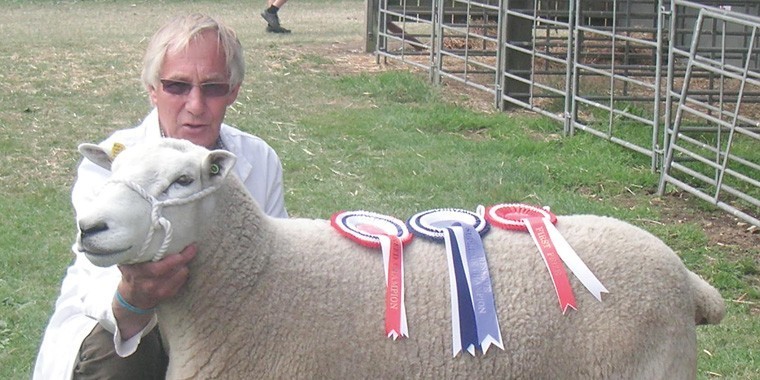With lambing finally complete, the last Herdy in the boss’s little flock never did lamb. She was showing a bit of an udder, but nothing more; she hasn’t changed at all, so we finally concluded that it was simply a bit of fatty tissue. There is a chance that she may still lamb as the ram ran with them all winter (for convenience) but I suspect not; I think it was hope rather than expectation.
This serves as a timely reminder that we really ought to get the Herdys scanned next year. The empty one will no doubt come again, just one of those things. The boss is, however, very pleased with her little group; of the five ewes lambing she had four sets of twins and a single, producing just two ram lambs and seven (78%) ewe lambs. I wish the Lleyn would be as accommodating; they only managed 59% ewe lambs.
With plenty of grass in front of their mums, the Lleyn lambs are growing on well. With a high Nematodirus warning and the unseasonably warm April bringing an increased risk of flies, they all came into the yard last week for a dose of wormer and some fly prevention. I really was pleasantly surprised with how well grown the lambs looked close up. I should, while I had the opportunity, have grabbed one or two and put them on the scales, but they will now have to wait for their eight-week weights. It will be interesting to put some objective figures on their performance, particularly as I have been a bit tough on the ewes with regards to hard feed this year; it will be very useful to see what impact it has or has not had on ewe milk production and the lamb growth rates.
With only permanent pasture, some not always the best, and not using any fertiliser, getting the desired outcomes from what are high performing ewes can be a bit demanding without resorting to some input of hard feed, but I have never been inclined simply to accept the status quo. With the ewes in good condition approaching lambing, I have challenged them this season. I just hope that I was not too challenging; that said, in the current production climate we all need to be looking at ways to reduce our costs of production and hard feed is an expensive input.
The eight-week weights will hopefully provide some indication as to how the ewes have coped with the challenge and provide some useful steer as to which ewe lambs should be identified as potential replacements; working on the assumption that the most efficient ewes should (in theory) produce the more efficient lambs.
I am sure that most have enjoyed the nice, warm, sunny days during lambing, particularly in April, but (there is always a but with farmers), we really could do with some decent rainfall fairly soon; without some significant precipitation moving into May, grass growth will begin to suffer quite dramatically. There is a bit of moisture at depth, but not a great deal. With January and February only providing about 50mm of rain this year compared to 160mm (East Malling weather station data) last year we started at a bit of a disadvantage; soil moisture levels simply were not where they needed to be. Fingers crossed that things do pick up once we get into May or this summer may be one of tight grass supplies.
The saying goes that Britain “has lots of weather but no climate”, a maxim that year on year is becoming increasingly true. We certainly have lots of weather, some quite extreme, but really do not have any reliable or predictable climate patterns, which makes grazing management rather more difficult and complex now than I ever recall it being. We’ve always had seasonal variations, but these do seem to be becoming increasingly extreme; the average grass growth curve with its twin peaks that many of us recall from college has frequently ceased to have any relevance.
The decision now is whether to continue with my planned summer grazing plan or extend the grazing time in each paddock in an attempt to conserve grass stocks in front of them. The aim was to graze lighter with more frequent shifts, leaving rather more residue to facilitate quicker regrowth and enhance soil organic matter (and moisture retention); to leave a bit for the worms and the soil, so to speak, but with no rain this could all come to naught.
As weather patterns change and more extreme weather events become the norm, soil health becomes increasingly important; a healthy soil is a resilient soil, but unfortunately the widespread use of artificial fertilisers has enabled us to neglect soil health and lose resilience. What previously would have been provided by good soil husbandry has, over the past 60 or 70 years, been largely supplanted by what we are able to source out of a bag.
So, where do we go from here? With fertiliser prices rocketing we cannot simply rely on, nor afford, the idea of simply applying a bit of extra bagged nitrogen. We need to look at rebuilding soil health and let the soil work for us once again; woefully some soils have been depleted to such an extent that they may be very difficult to revive. As sheep producers with the benefit of some very effective manure spreaders, good recyclers of organic fertlisers, we have not reached that point, but still need to be cognisant of potential problems and react accordingly. Just what an appropriate reaction might be depends very much on individual situations, but it is an area that does deserve, if not need, to be given some careful consideration.
Just a thought; according to the UN, some 40% of the world’s soils have been degraded and as F D Roosevelt once said: “The nation that destroys its soil, destroys itself.” Where do we go from here?




